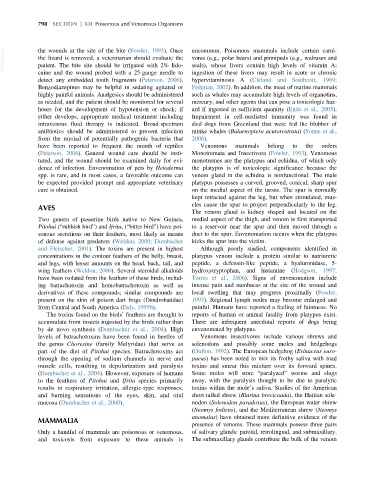Page 840 - Veterinary Toxicology, Basic and Clinical Principles, 3rd Edition
P. 840
798 SECTION | XII Poisonous and Venomous Organisms
VetBooks.ir the wounds at the site of the bite (Fowler, 1993). Once uncommon. Poisonous mammals include certain carni-
vores (e.g., polar bears) and pinnipeds (e.g., walruses and
the lizard is removed, a veterinarian should evaluate the
seals), whose livers contain high levels of vitamin A;
patient. The bite site should be irrigated with 2% lido-
caine and the wound probed with a 25-gauge needle to ingestion of these livers may result in acute or chronic
detect any embedded tooth fragments (Peterson, 2006). hypervitaminosis A (Cleland and Southcott, 1969;
Benzodiazepines may be helpful in sedating agitated or Fishman, 2002). In addition, the meat of marine mammals
highly painful animals. Analgesics should be administered such as whales may accumulate high levels of organotins,
as needed, and the patient should be monitored for several mercury, and other agents that can pose a toxicologic haz-
hours for the development of hypotension or shock; if ard if ingested in sufficient quantity (Endo et al., 2005).
either develops, appropriate medical treatment including Impairment in cell-mediated immunity was found in
intravenous fluid therapy is indicated. Broad-spectrum sled dogs from Greenland that were fed the blubber of
antibiotics should be administered to prevent infection minke whales (Balaenoptera acutorostrata)(Sonne et al.,
from the myriad of potentially pathogenic bacteria that 2006).
have been reported to frequent the mouth of reptiles Venomous mammals belong to the orders
(Peterson, 2006). General wound care should be insti- Monotremata and Insectivora (Fowler, 1993). Venomous
tuted, and the wound should be examined daily for evi- monotremes are the platypus and echidna, of which only
dence of infection. Envenomation of pets by Heloderma the platypus is of toxicologic significance because the
spp. is rare, and in most cases, a favorable outcome can venom gland in the echidna is nonfunctional. The male
be expected provided prompt and appropriate veterinary platypus possesses a curved, grooved, conical, sharp spur
care is obtained. on the medial aspect of the tarsus. The spur is normally
kept retracted against the leg, but when stimulated, mus-
cles cause the spur to project perpendicularly to the leg.
AVES
The venom gland is kidney shaped and located on the
Two genera of passerine birds native to New Guinea, medial aspect of the thigh, and venom is first transported
Pitohui (“rubbish bird”) and Ifrita, (“bitter bird”) have poi- to a reservoir near the spur and then moved through a
sonous secretions on their feathers, most likely as means duct to the spur. Envenomation occurs when the platypus
of defense against predators (Weldon, 2000; Dumbacher kicks the spur into the victim.
and Fleischer, 2001). The toxins are present in highest Although poorly studied, components identified in
concentrations in the contour feathers of the belly, breast, platypus venom include a protein similar to natriuretic
and legs, with lesser amounts on the head, back, tail, and peptide, a defensin-like peptide, a hyaluronidase, 5-
wing feathers (Weldon, 2000). Several steroidal alkaloids hydroxytryptophan, and histamine (Hodgson, 1997;
have been isolated from the feathers of these birds, includ- Torres et al., 2006). Signs of envenomation include
ing batrachotoxin and homobatrachotoxin as well as intense pain and numbness at the site of the wound and
derivatives of these compounds; similar compounds are local swelling that may progress proximally (Fowler,
present on the skin of poison dart frogs (Dendrobatidae) 1993). Regional lymph nodes may become enlarged and
from Central and South America (Daly, 1995b). painful. Humans have reported a feeling of faintness. No
The toxins found on the birds’ feathers are thought to reports of human or animal fatality from platypus exist.
accumulate from insects ingested by the birds rather than There are infrequent anecdotal reports of dogs being
by de novo synthesis (Dumbacher et al., 2004). High envenomated by platypus.
levels of batrachotoxins have been found in beetles of Venomous insectivores include various shrews and
the genus Choresine (family Melyridae) that serve as solenodons and possibly some moles and hedgehogs
part of the diet of Pitohui species. Batrachotoxins act (Dufton, 1992). The European hedgehog (Erinaceus euro-
through the opening of sodium channels in nerve and paeus) has been noted to mix its frothy saliva with toad
muscle cells, resulting in depolarization and paralysis toxins and smear this mixture over its forward spines.
(Dumbacher et al., 2004). However, exposure of humans Some moles will store “paralyzed” worms and slugs
to the feathers of Pitohui and Ifrita species primarily away, with the paralysis thought to be due to paralytic
results in respiratory irritation, allergic-type responses, toxins within the mole’s saliva. Studies of the American
and burning sensations of the eyes, skin, and oral short-tailed shrew (Blarina brevicauda), the Haitian sole-
mucosa (Dumbacher et al., 2000). nodon (Solenodon paradoxus), the European water shrew
(Neomys fodiens), and the Mediterranean shrew (Neomys
anomalus) have obtained more definitive evidence of the
MAMMALIA
presence of venoms. These mammals possess three pairs
Only a handful of mammals are poisonous or venomous, of salivary glands: parotid, retrolingual, and submaxillary.
and toxicosis from exposure to these animals is The submaxillary glands contribute the bulk of the venom

